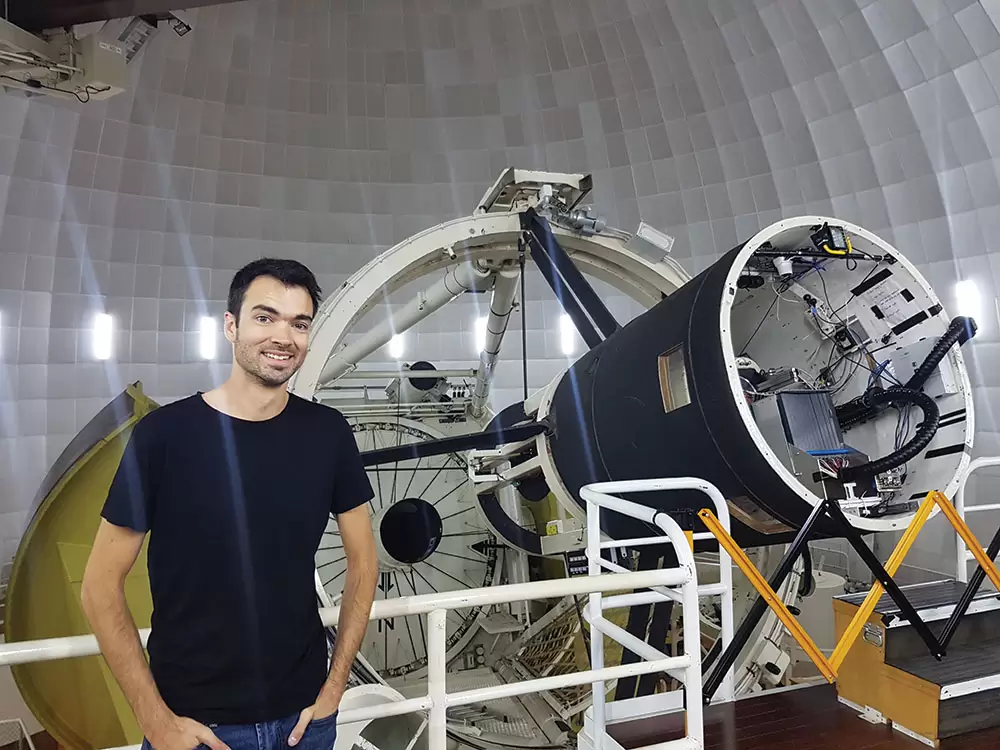Veloce Rosso is a world-class planet-hunting instrument, but its budget was anything but astronomical.
It is the size of a car, costs a fraction of its competitors and has been charged with seeking out Earth-sized planets in distant solar systems.
But it is not just a remarkable piece of engineering; it is also an ingenious piece of scientific equipment — a precision radial velocity spectrograph, to be precise — that promises to expand the horizons of human knowledge.
Already in operation at the Anglo-Australian Telescope (AAT), a 3.9 m telescope housed at Siding Spring Observatory, New South Wales, the Veloce Rosso project was conceived by University of New South Wales astronomer Professor Chris Tinney. The design, however, is the work of Lead Engineer Dr James Gilbert and his team at the Australian National University’s Advanced Instrumentation and Technology Centre.

“An astronomer will have a goal and at least some theoretical knowledge about what’s possible with technology,” Gilbert told create.
“Translating that into real engineering requirements, and, of course, doing so within finite resources, that’s the difficult thing. You can achieve almost anything with infinite money and time.”
Watching for wobbles
For Gilbert, those time and money constraints played a big part in how he approached the task.
“We have to operate within the realm of Australian research funding. There’s no private funding for this kind of thing,” he said. “The key becomes getting as much as you can out of the limitations of that grant.”
For this project, most of the funding came in the form of an Australian Research Council grant, with a total cost around $2 million.
The performance of Gilbert’s instrument, however, compares to international equivalents that cost 10 times as much.
How did he do it? Some smart engineering was the key.
A spectrograph is a device that can be attached to a telescope, such as the one at Siding Spring Observatory, and used to measure properties of the light it receives within a particular part of the electromagnetic spectrum.
Veloce Rosso, as its name suggests — rosso is Italian for red — examines the red end of the visible light spectrum, where many planet-hosting stars emit a significant fraction of their light. The team is currently upgrading the spectrograph to also examine green and blue light.
“Veloce Rosso is what they call a precision radial velocity spectrograph, which in simple terms means it’s an astronomical instrument that can look at the light content of stuff very accurately,” is how Gilbert explains it.
“And the key is the accuracy, because spectrographs have been around for some time. They’re nothing new — not for astronomy — but these days we’re really pushing the sensitivity of these instruments to a point where we can detect minuscule Doppler shifts in stars, which means we can infer the presence of a planet.”
Doppler shifts refer to the change of the colour of light when its source and an observer are moving toward or away from each other.
As a planet orbits its star, the star moves slightly closer to and farther from observers on Earth due to the gravitational tug of the planet. While doing so, the wavelength of the light coming from it will squeeze and stretch, changing its colour slightly. A regular rhythmic shift between redder and bluer light from a star suggests the presence of a planet.
“We can look at a star and we know the pattern that we expect to see. It’s like a signature unique to that kind of star, and those stars are all over the place in our galaxy,” Gilbert said.
“Because you know the pattern of the spectrum so well, you can actually look for slight changes.”
However, these stars are so distant and the planets that orbit them are so small in comparison — and so far from us — any spectrograph hoping to detect their presence must be carefully calibrated and kept in extremely stable conditions.
That is why most versions of these instruments are operated at temperatures of a few tens of Kelvin and inside a vacuum chamber.
“And that has to be stable for years, as well,” Gilbert clarified.
“If you’re looking for Earth-like planets, you have to be able to at least calibrate well enough to come back in weeks’ time and look at the same target and get the same sensitivity.”
Room-temperature operations
Gilbert’s team achieved the required stability — within one milliKelvin in temperature and one millibar in pressure — without using expensive cryogenic solutions.
“To put something the size of a car in a vacuum cryogenic environment is doable, but not practical,” he said.
“The solution was, in our case: instead of cryogenic, can we keep it at room temperature but very stable? And instead of a vacuum environment, can we actually keep it roughly at atmospheric pressure?”
In fact, the device is kept in slightly over-pressured conditions.
“It becomes a problem of controlling precisely rather than eliminating the problem entirely,” Gilbert said.
To ensure that these conditions don’t shift over time, the instrument is continually calibrated with reference to a highly stable laser called a laser frequency comb. That ensures that the spectrograph can always be returned to its necessary operating specifications.
“You don’t want to get too complicated,” Gilbert said.
“Everything can be broken down to very simple systems, if you look at it the right way. And in our case for the temperature, it’s as simple as putting the whole instrument in an air-conditioned box.”
That air-conditioning maintains stability within one degree Celsius, and is slightly cooler than the team wants the instrument to be.
“Then you just cover the metal box which this thing lives in,” Gilbert said. “You cover the enclosure with lots of small heaters, and these are just resistors. These are just simple power resistors that you would put in any other project.”
Using this method, it takes a while to tune the conditions to the desired settings, but, having done so, Gilbert has left Veloce Rosso in the hands of the researchers and astronomers at the observatory.
Veloce Rosso is currently available for use by anyone in the astronomical community.
“There’s this secret land where you really walk the line between science and engineering,” Gilbert said.
“Which, for me, is perfect, because it’s not truly commercial engineering for the sake of making products. It is for a pursuit that I’m really interested in — and it’s for a scientific pursuit — but it is formal engineering and you’re making real things and real decisions.”
Space to grow
Gilbert said the Veloce Rosso is an example of Australia’s outsize contribution to the world of astronomy.
“Australia does punch above its weight in many areas and has done for many years,” he said.
“It’s world renowned in areas that really have received only modest funding, and that’s because of the innovative approach that scientists and engineers have been able to take together.”
And that plays out in other space-related realms as well.
Supporting member on Engineers Australia’s National Space Committee Stephen Bornstein MIEAust CPEng points to the work of Queensland-based Gilmour Space Technologies as another pioneer in this regard.
“They’re probably the only company in Australia having a real crack at building something that’s offering launch capability,” he told create.
“I think they’ll get there, particularly with the support they’re receiving from the Government, and from the Air Force as well. I think there’s a strategic interest in having a sovereign launch capability.”
